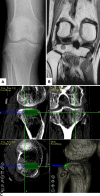Navigation-assisted surgery for bone and soft tissue tumors with bony extension
- PMID: 22009710
- PMCID: PMC3238002
- DOI: 10.1007/s11999-011-2094-5
Navigation-assisted surgery for bone and soft tissue tumors with bony extension
Abstract
Background: The navigation system was introduced to orthopaedic surgery in the 1990s. More recently, CT-based navigation systems have been used more commonly in spine and joint replacement surgery because of their precision.
Questions/purposes: The aim of our study was to evaluate the accuracy and efficacy of navigation-assisted excision of bone and soft tissue tumors.
Methods: From 2006 to 2009, we performed navigation-assisted surgery in 16 patients, 11 males and five females, with a mean age of 39 years (range, 13-70 years). We diagnosed nine benign bone tumors and seven malignant bone and soft tissue tumors. In two patients, the malignant soft tissue tumors infiltrated the adjacent bones. Nine excisional biopsies for benign tumors and seven en bloc excisions for malignant tumors were performed. In all cases, the point registration method was performed using 10 skin markers, which were placed around the tumor. Each excisional difference between the preoperative and postoperative plans was evaluated histologically or by postoperative CT.
Results: The mean accuracy of this system, which was determined using skin markers, was 0.93 mm (range, 0.6-1.2 mm). All biopsy and excision samples were evaluated by pathologic examination and postoperative CT imaging. The mean difference between the planned margin and postoperative CT or excised histologic specimen was 0 mm to 4 mm. The mean followup was 34 months (range, 10-54 months). There were no local recurrences, except for excision of skip metastases in a patient with a chordoma.
Conclusion: We report our experience with navigation-assisted surgery for bone and soft tissue tumors. Navigation-assisted surgery could be indicated for sufficiently reliable, accurate, and minimally invasive resections.
Figures





Similar articles
-
Is Navigation-guided En Bloc Resection Advantageous Compared With Intralesional Curettage for Locally Aggressive Bone Tumors?Clin Orthop Relat Res. 2018 Mar;476(3):511-517. doi: 10.1007/s11999.0000000000000054. Clin Orthop Relat Res. 2018. PMID: 29529633 Free PMC article.
-
Computer navigation-assisted surgery for musculoskeletal tumors: a closer look into the learning curve.Eur J Orthop Surg Traumatol. 2017 Aug;27(6):851-858. doi: 10.1007/s00590-017-2004-y. Epub 2017 Jun 24. Eur J Orthop Surg Traumatol. 2017. PMID: 28647781
-
Are Skin Fiducials Comparable to Bone Fiducials for Registration When Planning Navigation-assisted Musculoskeletal Tumor Resections in a Cadaveric Simulated Tumor Model?Clin Orthop Relat Res. 2019 Dec;477(12):2692-2701. doi: 10.1097/CORR.0000000000000924. Clin Orthop Relat Res. 2019. PMID: 31764337 Free PMC article.
-
How intraoperative navigation is changing musculoskeletal tumor surgery.Orthop Clin North Am. 2013 Oct;44(4):645-56. doi: 10.1016/j.ocl.2013.07.001. Orthop Clin North Am. 2013. PMID: 24095079 Review.
-
Practical use of imaging technique for management of bone and soft tissue tumors.J Orthop Sci. 2017 May;22(3):391-400. doi: 10.1016/j.jos.2017.01.006. Epub 2017 Feb 1. J Orthop Sci. 2017. PMID: 28161235 Review.
Cited by
-
Navigation-Guided Endoscopy Combined with Deep Lateral Orbitotomy for Removal of Small Tumors at the Lateral Orbital Apex.J Ophthalmol. 2018 Nov 25;2018:2827491. doi: 10.1155/2018/2827491. eCollection 2018. J Ophthalmol. 2018. PMID: 30595911 Free PMC article.
-
Percutaneous Image-guided Needle Biopsy of Musculoskeletal Tumors: Technical Tips.Interv Radiol (Higashimatsuyama). 2021 Apr 15;6(3):75-82. doi: 10.22575/interventionalradiology.2020-0030. eCollection 2021 Nov 1. Interv Radiol (Higashimatsuyama). 2021. PMID: 35912278 Free PMC article. Review.
-
Use of Computer Navigation in Orthopedic Oncology.Curr Surg Rep. 2014 Feb 22;2(4):47. doi: 10.1007/s40137-014-0047-0. eCollection 2014. Curr Surg Rep. 2014. PMID: 24672747 Free PMC article. Review.
-
3D printing for patient-specific implants in musculoskeletal oncology.EFORT Open Rev. 2023 May 9;8(5):331-339. doi: 10.1530/EOR-23-0066. EFORT Open Rev. 2023. PMID: 37158428 Free PMC article. Review.
-
Advances in Virtual Cutting Guide and Stereotactic Navigation for Complex Tumor Resections of the Sacrum and Pelvis: Case Series with Short-Term Follow-Up.Bioengineering (Basel). 2023 Nov 22;10(12):1342. doi: 10.3390/bioengineering10121342. Bioengineering (Basel). 2023. PMID: 38135933 Free PMC article.
References
-
- Athwal GS, Pichora DR, Ellis RE, Rudan JF. A computer-assisted guidance technique for the localization and excision of osteoid osteoma. Orthopedics. 2004;27:195–197. - PubMed
-
- Berlemann U, Langlotz F, Langlotz U, Nolte LP. [Computer-assisted orthopedic surgery: from pedicle screw insertion to further applications] [in German] Orthopade. 1997;26:463–469. - PubMed
Publication types
MeSH terms
LinkOut - more resources
Full Text Sources
Medical
Research Materials

